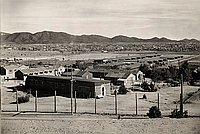Santa Fe riot facts for kids

The Santa Fe Internment Camp
|
|
| Date | March 12, 1945 |
|---|---|
| Location | Near Santa Fe, New Mexico, United States |
| Outcome | 4 ethnic Japanese internees seriously injured |
The Santa Fe riot was a clash at a special camp near Santa Fe, New Mexico. This happened during World War II on March 12, 1945. The camp held people of Japanese descent who were called "internees."
About 275 internees gathered to protest three men being moved to another camp. A fight broke out between the internees and the Border Patrol agents guarding the camp. The agents used tear gas and sticks called batons. Four internees were badly hurt.
Contents
Why the Camp Was There
In February 1942, the Department of Justice bought land in New Mexico. They used an old Civilian Conservation Corps camp to create a place for "enemy aliens." These were people from countries the U.S. was fighting, like Japan, Germany, and Italy.
The Santa Fe Internment Camp was different from other camps. It was guarded by Border Patrol agents, not soldiers. At first, it could hold 450 people. By March 1942, it grew to hold 1,400 people. The camp had wooden buildings and huts, which were later replaced by military-style barracks.
The first people held there were 826 Japanese men from California. They were later moved to other places. Then, people from Germany and Italy stayed there until 1943. In 1945, the camp got even bigger, to hold 2,100 Japanese people.
This second group included 366 young Japanese men from the Tule Lake War Relocation Center. These men had given up their U.S. citizenship. This made the government see them as "enemy aliens," so they were sent to special camps.
Tensions at the Camp
There had been some trouble at Camp Santa Fe before. In 1942, some local people marched towards the camp. They were upset about the Bataan Death March, where many American soldiers died. But the camp's leader convinced them to stop. He explained that attacking the camp could make things worse for American prisoners of war held by Japan.
The young men from Tule Lake were different from the older internees. They wore white headbands and acted in a very Japanese way. They had two main groups. One group wanted to return to Japan right away. The other group wanted to serve their home country. Some fights happened between these groups.
The Protest and Clash
On March 10, the camp guards searched the 366 men from Tule Lake. They took away many white shirts with the Rising Sun symbol. These shirts were like a uniform and were not allowed. The internees protested this.
Because of the protest, the camp's leader decided to move three of the protest leaders. They would go to Fort Stanton, another camp for "enemy aliens." The leader also added more guards. These guards had gas masks, submachine guns, and shotguns. They were told to be ready for trouble.
On the morning of March 12, about 250 to 300 internees gathered. They stood at the fence in front of the camp's main office. They wanted to watch the three men leave and protest their removal.
A fight started, and some internees began throwing rocks at the Border Patrol agents. The head of security, Abner Schrieber, asked the crowd to leave several times. When they did not, he ordered his men to fire tear gas into the crowd. The guards also used their batons.
The fight was quick. Four men were hurt badly enough to need hospital care. Their names were Mitsuo Hirashima, Akira Osugi, Gentaro Ono, and Isamu Uchida.
Eyewitness Account
Yasutaro Soga, an internee from Hawaii, later described what he saw in Japanese:
On March 12, 1945, the clash between the Tule Lake men and the Border Patrol reached its peak. It ended in a sad event. Early that morning, the chief of the liaison office, with guards, checked buildings. As we returned from breakfast, we saw Tsuha and Tachibana. Guards were with them and their bags. Many Tule Lake people followed them. There seemed to be no violence. But when the group got closer, dozens of guards were waiting.
Suddenly, the guards threw tear-gas grenades. But the wind blew the gas back towards the guards! The Tule Lake youths cheered. This started the incident. Guards with batons chased the men. They tried to trap them from both sides. Other guards also threw tear-gas grenades. All the guards hit the internees with sticks.
The men had no weapons to defend themselves. They fell down, one after another. Gontaro Ona, Akira Osuji, Isamu Uchida, and Motoi Hirashima all had head injuries. Much blood was shed. The guards put these four into a truck. They sent them to a hospital. I saw this cruelty. This incident happened very fast.
After the Clash
The conflict was short. However, 350 internees were separated from the others. They were put into a stockade, a fenced area, for several months. Seventeen other men were sent to the Fort Stanton internment camp. There were no more conflicts at Camp Santa Fe after this. Even when 399 more men from Tule Lake arrived, things stayed calm.
Camp Santa Fe stayed open even after the war ended on September 2, 1945. It was used to help Japanese internees return to their homes. The camp finally closed in May 1946. Today, houses stand where the camp used to be.
At the Rosario Cemetery, near the camp site, two men who died while interned are buried. In 2002, a large rock with a plaque was placed near the site. It tells about the camp and serves as a memorial.
Images for kids


